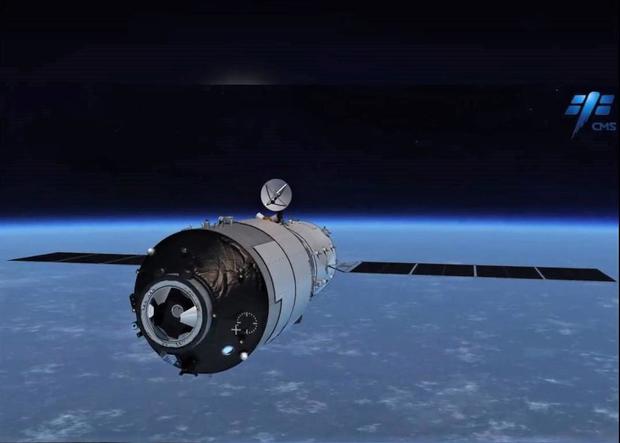
An artist's illustration of China's Tiangong-1 space lab in Earth orbit. China Manned Space Engineering Office
Most of it should burn up on re-entry, so scientists say it poses only a slight risk to people on the ground. Also, the United States Air Force 18th Space Control Squadron, which detects and tracks all artificial objects or particles in earth's orbit, had tracked the uncontrolled Tiangong-1 at the time of its re-entry to the Earth's atmosphere over the South Pacific.
The Tiangong-1 was launched in September 2011 as a prototype for China's ultimate space goal: a permanent space station which is expected to launch around 2022. JFSCC confirmed #Tiangong1 reentered the atmosphere over the southern Pacific Ocean at ~5:16 p.m. (PST) April 1.
China's Tiangong-1 space lab finally plummeted to Earth on Sunday evening, as scientists predicted.
"Space junk this size falls to Earth a few times a year", NPR's Nell Greenfieldboyce reports, but "it's usually something like a spent rocket stage - not a home-away-from-home for space travelers".
The bus-sized spacecraft re-entered Earth's atmosphere at approximately 8:16 p.m. EDT Sunday (0016 GMT Monday) over the southern Pacific Ocean, according to the US military's Joint Force Space Component Command, which tracks objects orbiting Earth using a network of radars and optical sensors.
Used for practising docking manoeuvres and techniques, the last crew left Tiangong 1 - which translates as Celestial Palace 1 - in 2013.
Earlier forecasts had said that only about 10 percent of the bus-sized, 8.5-ton spacecraft would likely survive re-entry, mainly its heavier components such as its engines.
Since then, it has orbited gradually closer and closer to Earth on its own while being monitored.
Philippines begins vote recount for VP
His lawyer, Vic Rodriguez, said Marcos' poll protest is historic because it was the first to have reached the recount stage. He pointed out that audit logs in 38 ballot boxes are very important as they contain the transactions made in a precinct.
India deny doping at Commonwealth Games after needles found
Tomorrow afternoon, another batch of Ugandan athletes, flies out to the Gold Coast; a journey lasting more than 20 hours.
Messi underscores importance to Barca
They could have punished us on the break but we had to take that risk and when you do that, there is always a possibility that you will be caught out.
During its extended flight, Tiangong-1 conducted experiments in space technology, space-earth remote sensing and space environment exploration, the office said.
Bill Ailor, of the Aerospace Corporation's Center for Orbital and Reentry Debris Studies, said that this re-entry is not particularly risky for people.
McDowell said the China space agency's initial estimate for re-entry was off because it "guessed wrong" about the time the space lab would leave its orbital path.
He said the danger to humans was small, with the likelihood of being hit by space debris lower than "being hit by lightning twice in the same year".
The first U.S. space station, the 74-ton Skylab, fell to Earth in an uncontrolled reentry in 1979.
Why did the space lab fall like this?
China also plans to put a man on the moon and send a rover to Mars.
Tiangong-1 was launched on September 29, 2011 and its service ended in March 2016. The spacecraft was meant to be a step towards making a permanently staffed space station of their own, as China is not a part of the operation of the International Space Station.
Recommended News
-
Comcast Corporation (CMCSA) now has a weekly volatility of 2.82%
Maximum and minimum EPS estimate for the current quarter is projected at $0.65 and $0.58, respectively, according to 18 analysts. Epoch Partners Inc has 6.35 million shares for 0.84% of their portfolio. 8,546 were accumulated by Cibc Asset.Russia's Foreign Ministry Summons Western Ambassadors Over Ex-spy Poisoning Dispute
The rest of victims went to Smolensk Square (home of Russian Foreign ministry) last Friday noon. The U.K. has already called in the OPCW to analyze the nerve agent used in the poison attack.WWE Has A Few Options For WrestleMania Main Event
The company reported $0.21 earnings per share for the quarter, beating the Zacks' consensus estimate of $0.20 by $0.01. The firm has a market cap of $1.35 billion, a P/E ratio of 56.85 and a beta of 0.76. (NYSE: WWE ) for 12,681 shares. -
NextEra Energy, Inc. (NEE)- Stocks Shining Bright on Wall Street
After $1.25 actual EPS reported by NextEra Energy, Inc . for the previous quarter, Wall Street now forecasts 37.60% EPS growth. This is calculated by taking weekly log normal returns and standard deviation of the share price over one year annualized.Supreme Court rejects appeal from Middle East attack victims
Police, who were on the other side of a chain-link fence and so not threatened, shouted at Hughes to drop the knife. A trial judge initially threw out the lawsuit, concluding the officer's use of force was reasonable.China Stresses Capacity to Counter US Protectionism
Soybeans were the top USA agricultural export to China a year ago , worth more than $12 billion. Faced with the prospect of a U.S. -
Police to release name of shooting victim after funeral
It is common for an outside agency to handle the investigation into an officer-involved shooting. The injured officer was taken to the hospital, where he was treated for swelling and bruising.Northeast Financial Consultants Inc Buys New Holdings in Nike (NKE)
The company reported the earnings of $0.46/Share in the last quarter where the estimated EPS by analysts was $0.4/share. After this sale, 141,709 common shares of NKE are directly owned by the insider, with total stake valued at $9,415,146.(NASDAQ:INTC) Shares Sold by Foster & Motley Inc
The chip maker reported $1.08 earnings per share (EPS) for the quarter, topping the consensus estimate of $0.86 by $0.22. A trend analysis is a method of analysis that allows traders to predict what will happen with a stock in the future. -
Dover police cracking down on distracted driving
Preliminarily, in 2017, there were nearly 50,000 crashes involving distracted driving in Florida. Police all across CT will be out in full force cracking down on distracted driving.Beyonce Is Reportedly Rehearsing 11 Hours A Day For Her Coachella Performance
The studio has been booked exclusively for Bey, her dancers, choreographers, technicians and other crew members. She was originally set for the 2017 edition of Coachella , but had to back out due to her pregnancy.Nurse Fired After Writing That Stephon Clark 'Deserved' To Be Fatally Shot
One of Clark's young sons said "hi" to protestors from the rally's stage and thanked them for demonstrating Saturday. The police department says it has not received an official autopsy report from the county coroner's office.










.jpg)














